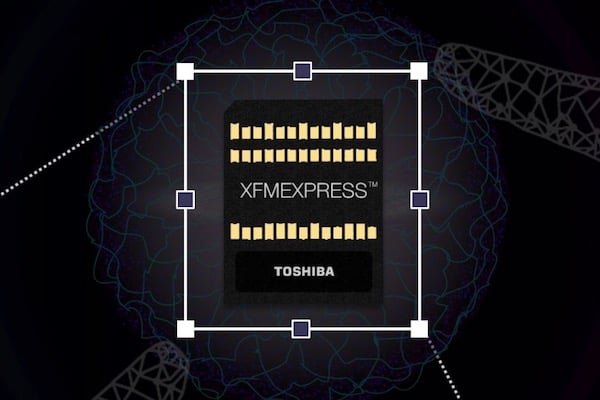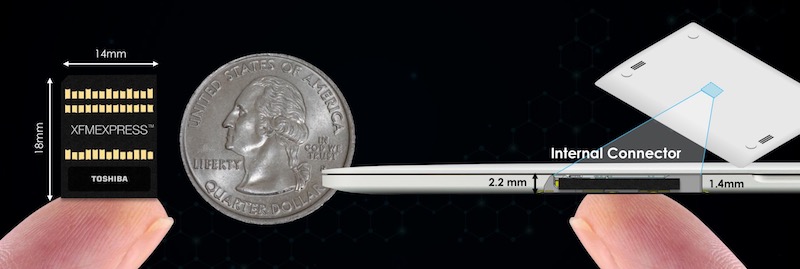Toshiba Memory Releases New NVMe Device Form Factor for “Ultra-Mobile” and Embedded Applications
Toshiba Memory has just announced a tiny, fast new memory form factor.
Toshiba Memory has just announced a tiny, fast new memory form factor.
Toshiba Memory Corporation (or Kioxia, as it will be called come October) has just unveiled the XFMEXPRESS, a new form factor technology for NVMe (non-volatile memory express) memory devices.

The XFMEXPRESS form factor. Image from Toshiba Memory
Before we dive into the specifics, it’s helpful to first touch base on some of the basics.
What Is NVMe?
NVMe is a communications standard and protocol that operates across the PCIe (peripheral component interface express) bus, aimed to fully realize the PCIe’s speed. NVMe was created from the ground up for NVM technologies in order to provide efficient access to NVM storage devices, like SSDs (solid-state drives).
NVMe protocol supports up to 64,000 queues, each of which is capable of up to 64,000 commands—all at the same time. To put that into perspective, typical SAS devices can handle up to 256 commands, and that drops to 32 commands for SATA devices, all in a single queue.
The bottom line is: NVMe is fast.
In addition, NVMe has streamlined the number of CPU instructions to process an I/O request to just 13 commands. This allows for lower latency and IOPS (input/output operations per second).
The XFMEXPRESS
When it comes to size, the XFMEXPRESS offers a compact footprint that’s “mobile-friendly,” featuring a small form factor (18 mm x 14 mm) and an optimized mounting space.

Left: A comparison of the XFMEXPRESS form factor to a quarter. Right: A demonstration of the size of the necessary internal connector. Image from Toshiba Memory
XFMEXPRESS also has a removable design, which can help when it’s time for an upgrade or service. The form factor is PCIe 3.0- and 4.0-capable, and can support between two and four lanes.
Furthermore, it’s designed to deploy current and future 3D flash memory sizes.
"Game-Changing Serviceability": Removable Memory
Toshiba Memory Corporation worked with JAE (Japan Aviation Electronics Industry, Ltd) on the XFMEXPRESS’ connector design and manufacturing. It boasts a few features, including:
- Hinge type connector
- Low profile and small size
- Lock structure
- Device removal possible in a small space
- Designed to enhance heat dissipation
- Supports PCIe® 4.0 (16GT/s) PCIe is a registered trademark of PCI-SIG.

A left-to-right, step-by-step demonstration of how to insert a removable memory device into the connector. Image from Toshiba Memory
XFMEXPRESS Applications
Since NVMe is designed to optimize the performance of non-volatile storage devices, the XFMEXPRESS targets a variety of markets. It can prove useful in consumer electronics, such as notebook PCs and ultra-mobile PCs, as well as gaming applications, such as console, VR (virtual reality) and HMD (head-mounted display).
One term that Toshiba utilizes here is "ultra-mobile" which is loosely associated with mobile devices that are necessarily exceptionally small, lightweight, reliable, and secure. Samsung, for example, refers to "ultra-mobile" healthcare professionals as those who leave "controlled environments" and venture into public spaces or patient homes.
The automotive industry is getting more and more advanced, especially with the increasing improvements in autonomous driving and connected car capabilities. As a result, storage capacity within the automobile has to keep up with data demands. With this in mind, Toshiba Memory Corporation sees the automotive industry as a key market for the XFMEXPRESS, specifically within EDR (endpoint detection and response), drive recorder, IVI (in-vehicle infotainment), and ADAS (advanced driver-assistance systems).
The XFMEXPRESS can also find its way into portable storage and surveillance applications.
NVMe Around the Industry
Toshiba Memory Corporation isn’t the only one developing NVMe devices. To name a few, Intel, Microsemi, Microsoft, and Samsung are also on the NVMe bandwagon. They all join more than 100 companies that offered NVMe-enabled products in 2018. It looks like that list may be getting larger in the future, with G2M Research predicting late last year that the NVMe market could reach $80 billion in revenue by 2022.
Do you think NVMe will become the dominant storage interface over the next few years? Tell us your thoughts in the comments below.








Do you think NVMe will become the dominant storage interface over the next few years? Consumer: Yes , Enterprise:No XFMEXPRESS’ connector design is much improved over M.2 Great work Toshiba Memory Corporation/Kioxia!